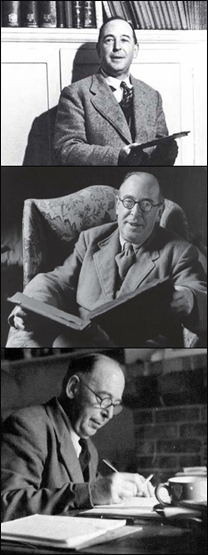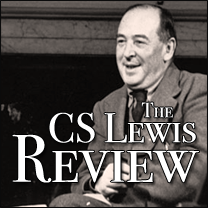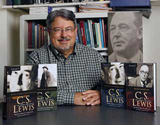
The Giant “Surmise”
August 22nd, 2005 | Skip to comments
The first non-Lewisian Narnian tale (or as the subtitle refers to it, “A Narnia Tale”) was published this year by HarperCollins, entitled, The Giant Surprise. It’s intended for “young readers” as a “picture book,” and, ostensibly provides a convenient way to tell a story drafting Puddleglum the Marshwiggle as the central character. I finally recently read this work while browsing in a prominent chain bookstore; it took me about 3 minutes. I don’t want to be unkind, but my judgment is that it is tediously unimaginative in its storytelling and uninteresting its illustrations. All of us have imagined a new Narnian tale. . . but how could this have been commissioned as the first one?
It’s intended for “young readers” as a “picture book,” and, ostensibly provides a convenient way to tell a story drafting Puddleglum the Marshwiggle as the central character. I finally recently read this work while browsing in a prominent chain bookstore; it took me about 3 minutes. I don’t want to be unkind, but my judgment is that it is tediously unimaginative in its storytelling and uninteresting its illustrations. All of us have imagined a new Narnian tale. . . but how could this have been commissioned as the first one?
The back cover says:
“Based on characters originally featured in C. S. Lewis’s The Chronicles of Narnia, The Giant Surprise is a brand new Narnia adventure story about Marshwiggles, giants, and mice for young children. Lally, a small wigglet, and her Uncle Puddleglum undertake a hair-raising rescue of their mice friends, before they become a giant’s supper. This new picture book-and the others in the series-shares the values of C. S. Lewis’s original work and explores a world of courage, kindness, and companionship.”
That’s a telling giveaway. (Read on.) Now, Puddleglum is one of my favorite Narnians, and one of Lewis’s most amusing creations, and, certainly his most distinctive non-protagonist: prominent for his sardonic Eeyore-like negativism, as well as his stalwart faith in Aslan. But he is a curious choice to build a story around for readers between 6-8 years old in a “picture book.” Curious not only because it is seemingly not possible to convey Puddleglum’s essential character in a very short work intended for very young readers (how much irony or cynicism or drollness can a normal, nonprecocious 6-8 year old reader pick up anyway?), but also because, well, he is not given much to do, and, what he is given to do (distract some giants from making some local mice their dinner while protecting his niece, Lally) is not very interesting or convincing. How so?
Well, let us just say that Lewis was the least likely author to imagine a universe in which giants are persuaded to give up their carnivorous inclinations because a Marshwiggle has asked them to play a game to distract them. Is this the clever and epigrammic Marshwiggle we come to love in The Silver Chair?? This is not plausible because Lewis had had no care for “games” or “sports” since childhood given his personal clumsiness and disdain for mere gamesmanship as observed in the bullies he boarded with in a succession of schools (except maybe for Scrabble, perhaps–his game of choice with Warnie and Joy. Now that would have been an intriguing plot twist–giants challenged to a game of Scrabble using Really Big Letters.)
But let’s get past this, and say that it is possible that a Marshwiggle of note might suggest such a gambit. And let us say that this is a reasonable premise for launching a new Narnian tale even though Lewis himself might not have recognized his creation or its provenance. Where is the wit, and the sly, winking narrative pose so characteristic of Lewis’s work? Surely that could be mastered, even as J. K. Rowling, in her early Harry, was able to do. Doesn’t the author have some obligation to emulate (or ghost write) such a tale in the Lewisian manner, even a little?
The fact that the book blurb has to point out that it “shares the values of C. S. Lewis’s original work” (oh, as if THAT would be the key draw in the young reader, or her parents) and “explores a world of courage, kindness, and companionship” means that it is in trouble. (I am sure Lewis would applaud the self-conscious and self-congratulatory inclusion of his “values” in the work. Not! Values-schmalues-how about some humor!) In fact, the book exhibits exactly the kind of “telling rather than showing” that Lewis decries in his essays about writing for children. For children do not read to discover “shared values,” but rather for the story itself–the values are a bonus which, if depicted well, do not announce themselves in the text, and thereby derail the reading experience. If characters are courageous, kind, and companionable, there is no need to point this out. And may I say that there is more to depicting giants than just rendering them tall and hungry? No, if we did not already know Puddleglum, we’d not care to meet him here; he looms as a generic hero, not a Narnian one.
The Giant Surprise is the most un-Peter Rabbit, anti-Water Babies, non-Amulet work (all childhood favorites of CSL) conceivable as a would-be “Narnia Tale.” It is desultory, unimaginative, uninspired, even amateurish. (How could this be?) There’s no Narnia cachet, no deep “magic,” let alone deeper magic–really no magic at all. It is as if someone was cooking up a formula for a children’s book and said, hmm, let’s add one part giant, one part mice, and one part Marshwiggle, and voila, there’s Narnia. Naw. That’s not what makes something Narnian. But let’s face it, the author is in a no win situation because of the inevitability of such comparisons; but the stakes are high. If you and I see the flaws, why not an editor at said publishing house? Lewis’s readership, even 6-8 year olds, deserve better.
I am sounding much too rakish here I suppose. But it is a shame that, if we have to have more Narnian tales (and I don’t agree that we do), that this has to its opening exemplar.
Sadly, the profound absence of whimsy, and tell-tale presence of heavy moralizing, make this an unfortunate entry in an unneeded successor to the seven canonical tales we have to treasure. Sigh.




Not to take issue with your on the mark nailing of the pseudo-Narnian tale, but there is a gaping hole in the marketplace, and the marketplace abhors a vacuum. We need more Narnia, even bad Narnia.
I was probably the first one in my little village to purchase said book, and certainly I was the first to toss it aside in disgust. Yet the character of Puddleglum has been haunting me and my house since we first met years ago. I need more of the little frog man egging me on, glumly pointing out why my plans are not going to work, and helping me to think things out a bit more. He really is full of pluck, and cheek. And I miss him.
Comment by kamran — 20 September 2006 @ 9:44 AM